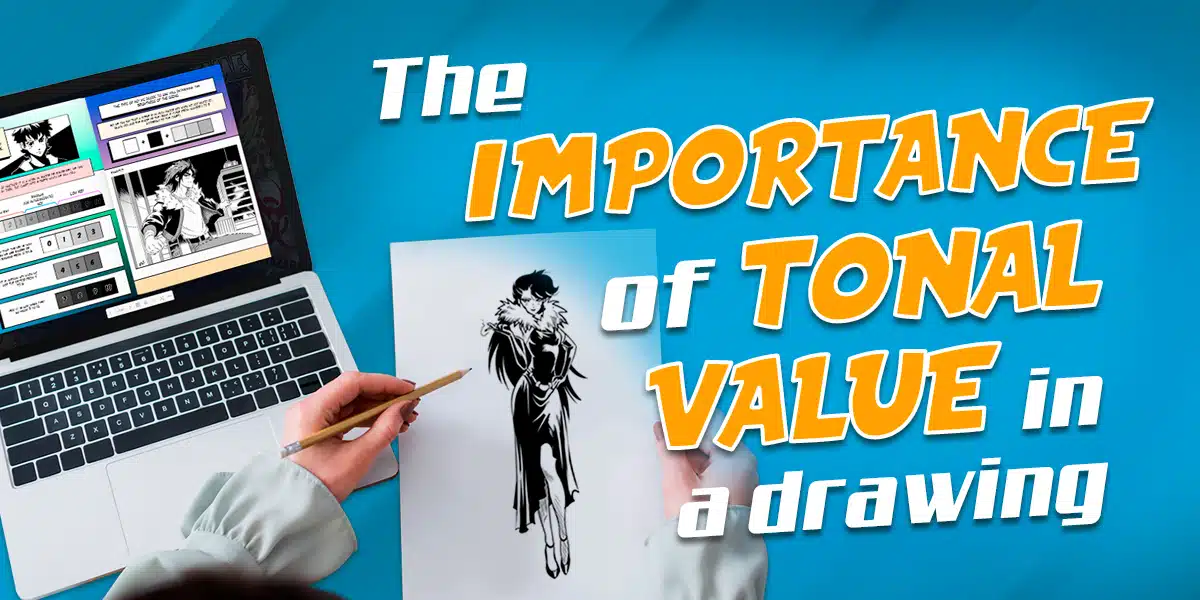What is Tonal Value in Drawing?
Tonal value is one of the most fascinating and fundamental elements in the art of drawing. It’s the magic that brings your creations to life, transforming simple lines into works full of depth and emotion. In this article, we’ll dive into the exciting world of tonal value, discovering how this concept can elevate your illustrations to a completely new level.
Get ready for a journey full of shadows and lights, where you’ll learn to master the grayscale, experiment with different materials, and discover techniques that will make your drawings come alive. Are you ready to unleash your full artistic potential? Keep reading and uncover the secrets of tonal value!
Tonal Value: The Key to Giving Life and Depth to Your Drawings
Imagine you’re in front of a blank canvas. You have your pencil in hand and a brilliant idea in your mind. But how do you make that two-dimensional idea come to life and jump off the paper? The answer lies in tonal value.
Tonal value in drawing is, essentially, the degree of lightness or darkness of a color. It’s the element that allows us to create the illusion of volume, depth, and atmosphere in our creations. Think of it as the secret language of shadows and lights, a code that, once deciphered, will allow you to communicate emotions and realism in your works like never before.
To understand value differences, artists often use a grayscale. On this scale, pure white and intense black make up the extremes, while a variety of gray tones are located between them. This tool is fundamental for any artist seeking to master the art of shading and take their illustrations to the next level.
When you’re starting out in the world of drawing, it’s common for most of your work to be in black and white. This isn’t a limitation, but an opportunity to master the use of tonal values. By working exclusively with grays, you learn to see the world in terms of light and shadow, a skill that will be invaluable when you decide to venture into the world of color.
Values in drawings are the index of light and the equivalent of color luminosity on surfaces. They are the key to creating the illusion of three-dimensionality in a two-dimensional medium. With mastery of tonal values, you can make a simple circle look like a sphere, a rectangle turn into a cylinder, and your characters seem to jump off the paper.
The Grayscale: Your Best Ally in Mastering Tonal Value

Master the Grayscale and Unlock Your Artistic Potential
The grayscale is to the artist what the musical scale is to the musician: a fundamental tool for developing technique and sensitivity. Practicing the grayscale is not just a technical exercise; it’s a journey of discovery that will allow you to see the world with new eyes.
Imagine you’re facing a landscape. Without the ability to perceive and reproduce tonal values, that landscape would be flat, without depth or atmosphere. But with mastery of the grayscale, you can capture the soft morning mist, the intensity of midday shadows, or the subtle evening light. Here you’ll find resources to perfect your handling of light and shadow in your illustrations.
Grayscales usually vary in length, ranging from 5 to more than 10 different tones. The basic structure generally starts with pure white, the lightest and brightest value. From there, light intermediate grays are introduced, those that are closer to white but already show a touch of shadow.
In the center of the scale, we find the intermediate grays. These are the most challenging and fascinating tones, as they maintain a perfect balance between light and darkness. Mastering these intermediate tones is crucial for creating smooth and realistic transitions in your drawings.
Moving towards the dark end, we have the dark intermediate values. These are the grays that begin to approach black, perfect for creating deep shadows and adding drama to your compositions. Finally, we reach the extreme black, the endpoint of our scale.
Each of these values has its place and purpose in drawing. Light values can represent the most illuminated areas or points of maximum brightness. Intermediate values are ideal for representing the transition between light and shadow, creating volume and form. Dark values, on the other hand, add depth and contrast, giving your drawings that touch of drama that can make the difference between a good work and an extraordinary one.
A Valuable Tip for Mastering the Grayscale

Mastering the grayscale may seem challenging, but with the right method, it can become a fluid and rewarding process. One of the most effective and practical methods for generating a grayscale from white to black, without problems between value passages, is as follows:
- Start by dividing your scale into a number of 5 or more cells. This number can vary depending on your level of experience and the complexity you want to achieve.
- Leave the first box completely white. This will represent the lightest value on your scale.
- Starting from the second cell, lightly paint all the remaining boxes with the same pressure. At this stage, you’re creating your first gray value, very close to white.
- Once you’ve completed that first passage, move to the third box. Now, with a little more pressure, paint the rest of the scale from this point. You’re creating your second gray value, slightly darker than the previous one.
- Repeat this process, gradually increasing the pressure, until you reach the black extreme in the last cell.
The key to this method is focusing on generating gradual passages. This will allow you to have an ordered variety of light, intermediate, and dark grays. With practice, you’ll achieve transitions so smooth they’ll seem to blend into each other, creating a perfectly graduated grayscale.
This exercise will not only help you improve your control over the pencil or tool you’re using, but it will also train your eye to perceive subtle value differences. It’s a skill that will be invaluable when working on more complex projects, allowing you to create illustrations with impressive depth and realism.
Remember, practice makes perfect. Don’t get discouraged if your first attempts aren’t perfect. Each time you repeat this exercise, you’ll notice improvements in your control and your ability to distinguish and reproduce different tonal values. Consistency is the key to success in the art of drawing!
Practical Exercises to Master Tonal Value
Theory is important, but true mastery comes with practice. Here I present a series of exercises that will help you develop your skill with tonal values. These exercises will not only improve your technique but also expand your creativity and your ability to see the world in terms of light and shadow.
1. Grayscales with Different Materials
There are different types of scales, with a greater or lesser number of values. The most common include between 5 and 10 varieties of grays. Although drawing generally involves working with black material on a white support, it’s recommended to experiment with all possibilities and different materials. Here are some ideas:
- Scale with black material on white paper (Example: Pen and black ink on white paper)
- Scale with white material on black paper (Example: White pen on black paper)
- Scale with white and black material on gray paper (White chalk pastel and charcoal on gray pastel paper)
Each material will offer you a unique experience and teach you different aspects of handling tonal values. Explore more techniques and materials here to expand your artistic skills.
2. Practical Application of the Grayscale
Once you’ve successfully created a series of scales, it’s time to use the same variety of grays in your drawings. Try the following:
- Choose a simple object, like a sphere or a cube.
- Draw the outline of the object.
- Using the values from your grayscale, start shading the object, paying attention to how light falls on it.
- Use the lightest values for the most illuminated areas and the darkest for the deepest shadows.
- Use intermediate values to create smooth transitions between light and shadow.
This exercise will help you understand how different tonal values can create the illusion of volume and three-dimensionality in a two-dimensional drawing.

Tonal Value and Its Relationship with Color
Although we’ve been talking mainly about white, black, and grays, it’s important to understand that the concept of tonal value extends to the world of color as well. Each color has its own inherent tonal value, which means that even in a full-color composition, the principles of tonal value remain crucial.
For example, yellow has a naturally light tonal value, while violet tends to be darker. However, this doesn’t mean these colors are limited to a single value. Any color can traverse the entire value scale, from lightest to darkest, simply by adding white or black.
Understanding this relationship between color and tonal value is fundamental to creating vibrant and balanced illustrations. It allows you to play with contrast not only in terms of color but also in terms of light and darkness. Discover how to apply these principles to create impactful illustrations.
Techniques for Generating a Variety of Grays with Different Materials
Each artistic material has its own characteristics and requires specific techniques to generate a wide range of tonal values. Mastering these techniques will give you incredible versatility as an artist. Let’s look at some of the most common:
Pen, Nib, and Fine-tip Markers
With fine-tip tools, the variety of tonal values is achieved through hatching. This is a fascinating process where the path of lines in different directions, overlapping, generates patterns that our eye perceives as different gray values.
- Open patterns (more distance between lines and fewer layers) = Lighter values
- Dense patterns (little space between lines and several layers) = Darker values

Graphite Pencil
The graphite pencil is perhaps one of the most versatile materials for working with tonal values. The key lies in pressure control and choosing the right type of pencil.
- Use soft pencils (2B, 4B, 6B, 8B) for gray work.
- Start with a light sweep for the lightest values.
- Gradually increase pressure to achieve darker values.
- Practice fine-tuning your movement to generate a wide spectrum of grays.
Remember, patience is key. Start with the lightest values and gradually build towards the darkest. Here you’ll find specific exercises to improve your pencil technique.

Paints: Acrylics, Temperas, and Oils
With these paints, the key to achieving different grays lies in balancing the proportions of black and white when mixing and preparing the palette. This process is like a dance between light and darkness, where you are the choreographer.
- 75% black + 25% white = Dark gray
- 50% black + 50% white = Intermediate gray
- 25% black + 75% white = Light gray
Experiment with these proportions and discover how small adjustments can create a wide range of shades. Explore more about painting techniques and how to apply them in your illustrations.
Black Ink
Black ink, especially India ink, offers an extreme black that can be diluted to create a variety of grays. This method is particularly effective for creating illustrations with high contrast and drama.
- Prepare several containers, one for each gray tone you want to create.
- Start with pure ink in the first container.
- For the next tone, take some of the pure ink and add water with a dropper.
- Repeat the process, adding more water each time to create lighter tones.

This method allows you to create a precise and controlled grayscale, perfect for detailed and atmospheric works. Discover how to use ink to create impactful illustrations.
Conclusion: The Transformative Power of Tonal Value
Throughout this article, we’ve explored the fascinating world of tonal value in drawing. We’ve seen how this fundamental element can transform simple lines into works of art full of depth, volume, and emotion. From the importance of the grayscale to specific techniques for different materials, every aspect of tonal value plays a crucial role in creating impactful illustrations.
Remember, mastering tonal value is not just a technical skill; it’s a way of seeing and understanding the world around you. With practice and patience, you’ll learn to perceive the subtle nuances of light and shadow that give life to everything we see. This skill will not only improve your drawings but also enrich your visual perception in everyday life.
We invite you to put what you’ve learned into practice. Experiment with different materials, create your own grayscales, and apply this knowledge to your drawings. Remember, every stroke is an opportunity to improve and every shadow is a step closer to artistic mastery.
Are you ready to take your illustrations to the next level? Click here to discover additional resources and advanced techniques that will boost your creativity. The world of tonal value awaits you, it’s time to dive in and unleash your full artistic potential!



